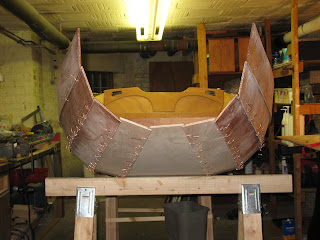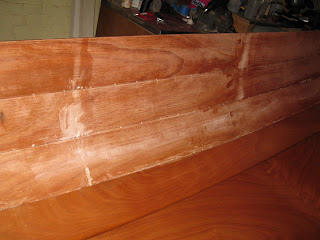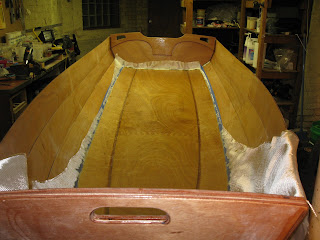It was a challenge to get the planks to snuggle up to each other, especially at the bow and stern. I broke a lot of wire. I started in the middle and worked to the ends. The first pass I got them in the ball park and then tightened again from middle to ends until I broke the wire. I replaced it and repeated the process until the ends came together. For the final 12 inches, I had to get a friend to help squeezed the planks together and I handled the wire.
 In the next step, epoxy is put into the seams. Here, I had another of my many opportunities for improvement. I made up the mix of epoxy and Cab O Sil too thin, while I wanted to make sure it got deep into the joint , I found out when I turned the boat over to do the other side that I had a lot of epoxy drip thru and actually glue the bulkheads to the hull. This added several hours of clean up and some damage chiseling the parts apart.
In the next step, epoxy is put into the seams. Here, I had another of my many opportunities for improvement. I made up the mix of epoxy and Cab O Sil too thin, while I wanted to make sure it got deep into the joint , I found out when I turned the boat over to do the other side that I had a lot of epoxy drip thru and actually glue the bulkheads to the hull. This added several hours of clean up and some damage chiseling the parts apart. When I filled the wire holes, I used a putty knife and used a technique much like filling dry wall nail holes. I did not clean up too well and left spots that needed sanding later. When I filled nail holes in the inside and elsewhere, I used alcohol to wipe up the excess left by the putty knife. This eliminated a few hours or sanding.
Applying the fiberglass to the bottom of the boat went well. I used the suggested amount of epoxy and it spread out nicely. The inside was another story. I could not get the epoxy to spread out to the edges. I poured it into the middle as suggested in the manual. I had to use extra epoxy to wet out all the glass. In fact after I got done I added up the epoxy used and found I had used twice the amount suggested. It seemed to be OK, so I went off to bed expecting good results.
I came down an hour later and found bubbles and many areas where the glass cloth had lifted off the surface of the wood. I worked for an hour to try and smooth it out. I finally realized It was hopeless and removed the glass from the wood. I rolled and tipped the epoxy to reduce sanding time and had a stiff drink.
Here lies $30 worth of glass cloth and a lot of epoxy.
Oh Well still better than being out in the snow!
It worked out in the end. I found a local source for glass cloth and this time I poured the epoxy around the edges of the inside and worked it towards the middle. Sometimes common sense is better than directions.
I found a better solution to removing the wire than using a lighter. My thumb got raw flicking by Bic to heat up the wires to remove them. I used my heat gun which worked very well and cut the time by 50%. I found I could heat the wire with one hand and pull with a pair of pliers in the other. A propane torch would work too, but a heat gun is safer.
The transoms were a challenge. The stern was a dream, but the bow was harder. I would advise making an effort to attach the forward transom even with the shortest panel. I wired it too far forward and had a gap to make up for. Strangely this mistake saved me from another one later on. I did not have my glasses on and mistook a 6 for an 8 and put the forward bulkhead two inched too far forward. As I had put the transom too far forward, it worked out. I would rather be lucky than good!









No comments:
Post a Comment